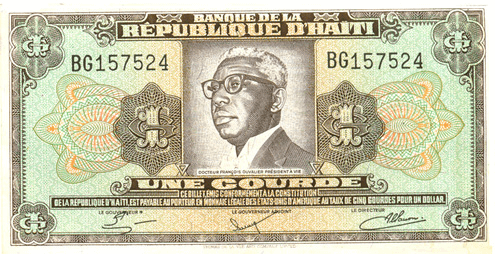Haitian gourde
The gourde is the currency of Haiti. Its ISO 4217 code is HTG and it is divided into 100 centimes (French) or santim (Creole).
First Gourde, 1813-1870. The first gourde was introduced in 1813 and replaced the livre at a rate of 1 gourde = 8 livres and 5 sous. The first issues of coins were silver pieces of 6, 12 and 25 centimes. In 1827, 50 and 100 centimes coins were introduced, followed by 1 and 2 centimes in 1828. In 1846 and 1850, 6¼ centimes coins were issued as well as 6 centimes pieces. In 1863, bronze coins, produced by the Heaton mint of Birmingham, were issued. These were in denominations of 5, 10 and 20 centimes and were the last coins of the first gourde. The governments of Haiti issued paper money in denominations of 1, 2, 5, 10, 20, 25, 50, 100,and 500 gourdes.
Second Gourde, 1870-1872. In 1870 the gourde was revalued at a rate of ten to one. Only banknotes were issued for this second gourde, with the government issuing notes of 10 and 25 gourdes.
Third Gourde. In 1872, the gourde was again revalued, this time at a rate of three hundred to one. In the early years of this third gourde, only banknotes were being issued and the name piastre was sometimes used instead of gourde, especially on a banknote issue dated 1875. In 1881, the gourde was linked to the French franc at 5 francs = 1 gourde and coin production recommenced. The peg to the franc did not last but, in 1912, the gourde was pegged to the US dollar at a value of 5 gourdes to the US dollar. Although this peg was abandoned in 1989 and the currency now floats, because of the old link, five gourdes is often referred to as a "Haitian dollar". Likewise, 5 centimes is a "Haitian penny". Indeed, in many places, prices are given not in gourdes, but rather in "Haitian dollars", which must be multiplied by five to convert to gourdes.
The 1881 issue of coins consisted of denominations of 1, 2, 10, 20 and 50 centimes and 1 gourde. 5 centimes coins were added in 1889. Production of the 1 and 2 centimes and 1 gourde pieces ceased in the mid 1890s, whilst coin production ceased entirely from 1908 until 1949, when 5 and 10 centimes coins were again minted. These were followed by 20 centimes pieces in 1956, 50 centimes in 1972 and 1 and 5 gourdes in 1995. Coins currently in circulation are 50 centimes, 1 gourde, and 5 gourdes.
In 1875, banknotes were issued by the "National Bank of Haiti" in denominations of 25 centimes, 1 and 5 piastres (equal to gourdes). Following this, banknotes were issued in denominations ranging from 10 centimes to 5 gourdes by the various Haitian governments until 1916, when the "National Bank of the Republic of Haiti" began issuing notes. In 1920, 1, 2, 5, 10 and 20 gourdes notes were issued, with 50 and 100 gourdes added in 1925. In the 1970s, 25, 250 and 500 gourdes notes were introduced. In 1979, the Bank of the Republic of Haiti replaced the National Bank as the paper money issuing body. A 1000 gourdes note was introduced in 1999, to commemorate the 250th anniversary of the founding of Port-au-Prince. A 20 gourdes note was released into circulation in 2001, both as a commemorative (to celebrate the bicentennial of Constitution of Toussaint l'Ouverture) and as a regular issue. In 2004, the Banque de la République d'Haïti issued a series of notes to commemorate the bicentennial of Haiti. Banknotes currently in circulation are 10 gourdes, 20 gourdes, 25 gourdes, 50 gourdes, 100 gourdes, 250 gourdes, 500 gourdes and 1000 gourdes.
Note: The 1, 2, and 5 gourde notes are no longer produced and may no longer be in circulation.
 Français
Français